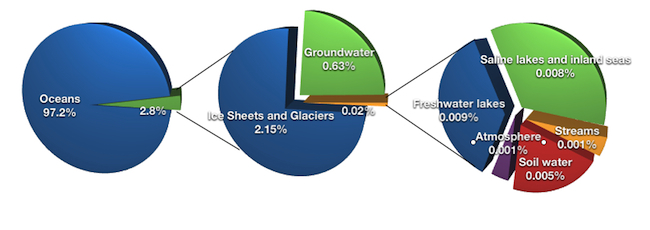|
Distribution of waterThe world's oceans contain 97% of the water in the hydrosphere, most of which is salt water. Ice caps, like that found covering Antarctica, and glaciers that occupy high alpine locations, compose a little more than 2% of all water found on earth. Seemingly a small amount, the water stored as ice in glaciers would have a great impact on the environment if it were to melt into a liquid. . Rising sea levels from melting ice sheets and glaciers due to global warming could devastate coastal cities, displace millions of people, and wreak havoc on freshwater systems and habitats.
Figure 10.2 Various stores of
water in the hydrosphere Water beneath the surface comprises the next largest store. Groundwater and soil water make up about .63% and 0.005% of all water (by volume). Soil water is the water held in pore spaces between soil particles. Soil pore spaces usually are partially void of water most of the time but fill with water after a rain storm. Groundwater is found where earth materials are saturated throughout the year. That is, the pore spaces are always occupied with water. Both soil and groundwater are very important sources of water. Soil water is available for plants to extract and use. Groundwater is an important source of water for irrigation and drinking water supplies. Above the surface water is found stored in streams, rivers and lakes. One might expect that given the large rivers that flow across the earth and the huge numbers of lakes that this store would be rather large. Instead, freshwater streams, rivers and lakes, and saline lakes and inlands seas comprise just under .03% of all water in the earth system. In the atmosphere, only about .0001 % of the water in the hydrosphere is found. Video: Water, Water
Everywhere
Assess your basic understanding of the
preceding material by "Looking
Back: The Hydrosphere" or skip and
continue reading. |
